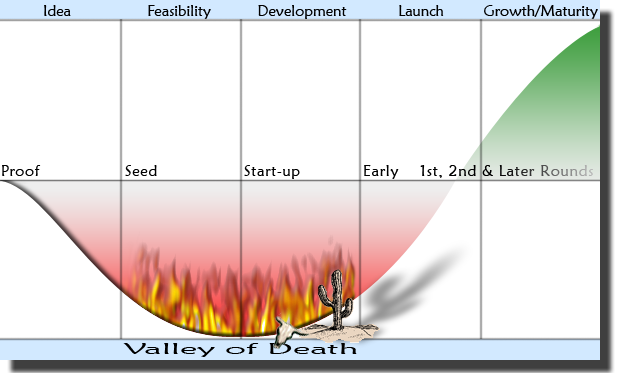
There are many blogs that attempt to teach bloggers how to generate long-term value. Most bloggers start out hoping to "get rich quick" and then flame out when they realize how difficult it is to monetize their efforts. Successful bloggers, on the other hand, take a slow and steady approach over many years.

Making money blogging is no different than any other startup. At first you must invest time and money building a business. It often takes years before you generate enough profit to cover the cost of your initial investment. Those who give up on their business before getting through the valley of death never see a return on their investment.
The partners in a startup are not paid salaries (because there is often little money), instead they are paid in shares. These shares represent the future value of the business after years of effort. If the partners attempt to cash out early they will receive next to nothing for their efforts. This is because their early effort only has value if they see their investment through to completion.
Solo Blogging Long Term Rewards the Traditional Way
As many of you are aware we have proposed simplifying payout period on posts to a single 7 day window. Some people have expressed concern that bloggers only get paid "once" and that makes Steem a sub-optimal place to blog compared more traditional systems that generate a ad revenue stream. So lets take a closer look at the traditional model.
A blogger, expecting to make it big, starts a limited liability company that owns his blog. He then spends money buying a domain name and pays monthly hosting costs. He deploys some free software (like Wordpress) and starts writing. Initially he has no audience, so he spends time and money to promote his blog and gain readers. It takes years to start making money.
If we take a best case scenario and consider an extraordinary blogger like, Steve Pavilina, who wrote a great article on "How to Make Money From Your Blog" then we can get a realistic "best case".
StevePavlina.com was launched on Oct 1st, 2004. By April 2005 (7 months later) it was averaging $4.12/day in income. After two years he was generating $1000/day in revenue.
That extraordinary success did not come easy, this man worked more than 40 hours per week for two years, spending 10 to 15 hours per blog post. He also invested a ton of time promoting his blog, learning technology, and optimizing for Google.
I usually aim for about 3-5 posts per week, but my posts are much longer (typically 1000-2000 words, sometimes longer than 5000 words).
That is a lot of work and it took him years with no income (or negative income) before it started really paying off. Lets be honest, most of us are not prepared to invest that heavily in earning money from our blog. We do not write frequently enough to generate recurring traffic or large organic SEO traffic. The revenue streams that worked for Steve in 2006 have long since dried up due to competition.
How much was each of Steve's posts actually worth? Individually they are worth next to nothing. Taken as a collection they are worth far more than the sum of their parts. If we assume he maintained revenue of $360,000 year for 10 years and posted 4 times per week then his average pay-per-post was about $1,400. He didn't get $1400 for each of his original posts, but those posts were what enabled him to build an audience that helped him monetize his later posts.
Cooperative Blogging Long Term Rewards via Traditional Means
Our own individual efforts rarely compound into the revenue stream that Steve Pavlina was able to achieve, but what if we didn't have to do it alone? What if we partnered with 100 people who each wrote one article per week spending 10 hours on it. Assuming all 100 people produced content of equal quality to what Steve was producing then they would generate 20 times the content of Steve Pavlina and in turn would achieve in 6 months what it took Steve 10 years to produce. Each of these people would own an equal share in a business generating $360,000 per year in revenue. At an obscene 20x future earnings, this business would be worth less than $10 million dollars and each blogger would have shares worth $100,000. Their average income per post would have been $3000.
The reality for the 100 bloggers is that their shares are only worth $100,000 if they keep producing the content necessary to sustain the $10 million dollar valuation. If they attempted to sell their shares and walk away then the market would greatly discount future earnings and a $100,000 valuation would drop to $10,000 and each blogger would be lucky to earn $300 per post.
You see, the value of your effort today is highly connected to your future effort and it relies heavily on compounding effects. If you stop producing content then your audience will dry up and fewer people will discover your old content.
Steem - The Ultimate Cooperative Blogging Platform
When you are paid STEEM in exchange for your post it is like receiving shares in a new blog. Early on those shares may be next to worthless, but if you see it through they can grow to be worth while. Imagine Steve Pavlina sold shares in his blog the first year of operation. He would have had some income, but it would hardly make him rich. Later, when his blog is generating $1000 per day he will find that most of that revenue is owed to his investors and that he would be lucky to bring home a basic wage. At any time the investors could hire someone else to produce similar content.
The only way to make a lot of money in this world is to spend your time building something you own. That can either be through starting your own business or partnering with others who are willing to share equity. If you are looking at the current value of the equity you are paid then you are doing it wrong. Your real pay day comes years later after your efforts compound to produce something of much greater value. Cashing out early denies you the benefit of this compounded return.
Those of you who earn $100 worth of STEEM today may see that STEEM worth $10,000 in the future after everyone's collective efforts compound. Sure, Steve Pavlina could have sold his articles for $100 each to some other self-improvement blog and brought home a minimal wage, but he didn't. He declined $100 dollars up front so he could realize $1400 in the future and bring home a $360,000 salary.
Conclusion
STEEM is its own long-term reward and there is no need to generate a revenue stream. Those that hold on to their STEEM naturally receive the long-term value that accumulates to the platform due to their post and everyone else's continuing efforts. It is far better to take your long-term gains as capital gains on STEEM than as regular income from ad revenue. This is even more true when you realize that STEEM has many sources of value that are far more lucrative than Google Ad Sense.
We could simulate the "long term" revenue model by paying everyone in STEEM POWER with a 10-year divesting period. You would post today and maybe earn $4.16 per day in liquid assets. If you keep posting for 10 years then eventually you will be claiming $1000 per day. Instead, we give everyone relatively liquid tokens. Those who sell today earn some money, but forgo the long-term revenue stream their content could earn them.
When someone buys the $1 of STEEM you earned today, they are buying the future revenue stream too. In other words, all STEEM payments are approximations for the net-present-value of all future revenue your post would earn discounted for risk and the fact that you are selling out and may stop producing content.
When you run your own blog you face significant risk, only 1 out of 20 full-time bloggers earn a middle class income. This means that the chances that you will achieve long-term return on your efforts must be discounted. When you join a cooperative effort like Steem, you diversify your risk at the expense of a lower maximum return on investment. This diversification still gives you compounding effects, but with a significantly lower chance of complete failure. Unlike solo-blogging, blogging as a team as the added advantage of network effect. This network effect means that the chance of community success is greater than the sum of the individuals.
